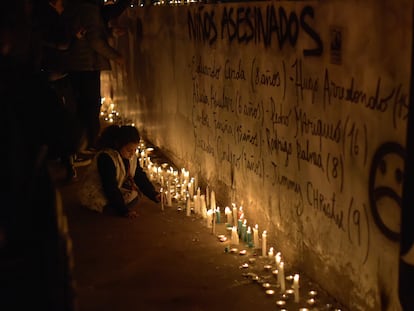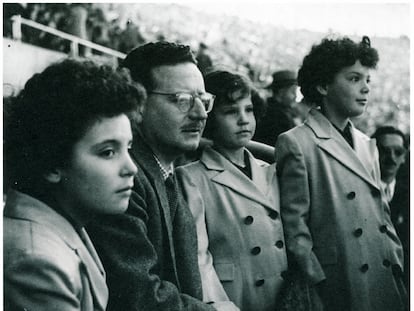How to design a revolution: The posters, records and spoons created during Salvador Allende’s Popular Unity government
The most unknown side of the socialist government – which ruled Chile between 1970 and 1973, until Pinochet’s coup d’état – has been revealed by an exhibition and a book: the prominence of graphic and industrial design

Under the Plaza de la Ciudadanía (“the plaza of the citizenry”) – which is in front of the southern facade of La Moneda, Chile presidential palace, in the capital of Santiago – those who appreciate history and art can find a treasure: the How to Design a Revolution exhibition.
Set up in the basement of the Cultural Center of La Moneda, there are hidden gems on display, which depict the important role that design played in the Popular Unity administration of President Salvador Allende (1970-1973). For the first time, a synthesis of the posters, editorials, furniture, record collections and even the spoons that were manufactured for the National Milk Plan – which provided half-a-litre of free milk daily to the most underprivileged Chilean children – is presented.
This past Tuesday, the curators of the exhibit – Eden Medina, Hugo Palmarola and Pedro Ignacio Alonso – presented a book of the same name, published by the Swiss publishing house Lars Müller Publishers. An extension of the exhibit, it’s a comprehensive record, with an analysis of the graphic and industrial design projects undertaken during the Allende era.
American researcher Eden Medina – associate professor of Science, Technology and Society at the Massachusetts Institute of Technology (MIT) – began researching Project Cybersyn 20 years ago. This was a revolutionary technological commitment that sought to control economic information coming from all corners of Chile during the Popular Unity administration. The author of Cybernetic Revolutionaries: Technology and Politics in Allende’s Chile (2014), Medina discusses how – while she was conducting her research – she met the designer Hugo Palmarola, from the Pontifical Catholic University of Chile, who was also researching Cybersyn.
Project Cybersyn consisted of various projects carried out by the Technological Research Committee during the Allende administration. Thinking about the 50 years since the commemoration of General Augusto Pinochet’s coup d’état last September, Medina and Palmarola decided to put together an original, innovative exhibition, where the protagonist was the explosion of creativity that marked Allende’s mandate. “We knew that there was another interpretation of history, of Popular Unity… and this was the [element of] design,” says Palmarola, in a tour of the exhibition.
The exhibition – a joint work between the Catholic University, MIT and the Cultural Center of La Moneda – brings together more than 350 pieces, most of them original, from political projects developed between 1970 and 1973. Many of them are linked to nutrition or music, going beyond traditional political campaigns. The core themes are the care of the population and children, in contrast to the lofty technological concepts of Project Cybersyn, whose operating room is meticulously replicated on the outskirts of the exhibition. There, visitors can experience how the government intended to implement and control a collectivist economic model throughout the country.
The main image of the exhibition – which is also the cover of the book – is a woman hugging faceless adults and children, based on a poster by designers Waldo González and Mario Quiroz. They chose her because she conveys the idea of a collective project, rather than that of a leader directing a political process. “One of the criticisms made of the Popular Unity government is the focus that was put on the men in the countryside, in the unions. The women may not appear as much in photos and posters… but the exhibition shows that they were [major] actors. [They were] creators of the programme and [leaders in] how they imagined the revolution,” Medina points out.
The context of how the projects impacted and coexisted with the society of that time plays a key role in the exhibition. There are images by photographers – mainly foreigners – such as the American Ted Polumbaum, the German Leonore Mau, or the Portuguese Armindo Cardoso. The effort to democratize art is reflected in how posters and murals wallpapered the cities, with the desire that the entire society could have access to works of graphic design. For the first time, the complete original collection of the Discoteca del Cantar Popular (DICAP, a discography of popular singing) – a record label that emerged between 1967 and 1973, put out by the Communist Youth of Chile – is on display. Albums by Inti Illimani and Quilapayún appear, for example, with covers designed by the brothers Vicente and Antonio Larrea. They are widely-recognized in Chile for their work on the posters and covers, rather than for their musical talent.
Then, there are the real gems, such as the only remaining copy of the 18 poster designs, which were drafted to support the anti-fascist days of protest, organized to prevent a coup d’état and civil war. About 9,000 copies were made of the works by the designers in the graphics workshop at the State Technical University. The curators note that Pinochet’s soldiers destroyed all the original designs, except for the one on display. “Each object in this exhibition has a 50-year-old survival story… it’s very significant,” Medina emphasizes.
The bulk of the exhibition is made up of originals, but in the case of extinct posters – such as some from the copper nationalization campaign – the curators worked together with the cartoonist Hernán Vidal (known as “Hervi”) to reconstruct them. One of the most notable efforts to replicate the objects from the early-1970s is the wall where the furniture that was designed specifically for the National Board of Nursery Schools – created in 1970 – is displayed. There are colorful chairs and tables that were built based on geometric figures, with ergonomic features… all very statically admirable. The same people who designed the ultra-avant-garde Cybersyn room used scraps of furniture to make everything from wooden toys to cribs.
“Just as there was the ideal of the ‘new man’ in the socialist bloc, we propose in this curatorship that the infrastructure is also for the ‘new child,’” Palmarola notes. An example of this is the milk-measuring spoon for infants. The exhibition can be seen on the enormous walls, but the spoon is displayed in the center of the room, as the heart of the proposal. “Here, the technical or scientific nutrition project is mixed with the political project,” adds the designer from the Catholic University. The object is complemented by the posters and photographs that accompanied the social welfare campaign.
The most significant stories from the design experience that took place during the Popular Unity government are recounted in the book How to Design a Revolution: The Chilean Road to Design. The English edition is set to be published in March of 2024.
Sign up for our weekly newsletter to get more English-language news coverage from EL PAÍS USA Edition
Sign up for our weekly newsletter to get more English-language news coverage from EL PAÍS USA Edition
Tu suscripción se está usando en otro dispositivo
¿Quieres añadir otro usuario a tu suscripción?
Si continúas leyendo en este dispositivo, no se podrá leer en el otro.
FlechaTu suscripción se está usando en otro dispositivo y solo puedes acceder a EL PAÍS desde un dispositivo a la vez.
Si quieres compartir tu cuenta, cambia tu suscripción a la modalidad Premium, así podrás añadir otro usuario. Cada uno accederá con su propia cuenta de email, lo que os permitirá personalizar vuestra experiencia en EL PAÍS.
¿Tienes una suscripción de empresa? Accede aquí para contratar más cuentas.
En el caso de no saber quién está usando tu cuenta, te recomendamos cambiar tu contraseña aquí.
Si decides continuar compartiendo tu cuenta, este mensaje se mostrará en tu dispositivo y en el de la otra persona que está usando tu cuenta de forma indefinida, afectando a tu experiencia de lectura. Puedes consultar aquí los términos y condiciones de la suscripción digital.
More information
Archived In
Últimas noticias
Most viewed
- Oona Chaplin: ‘I told James Cameron that I was living in a treehouse and starting a permaculture project with a friend’
- Sinaloa Cartel war is taking its toll on Los Chapitos
- Reinhard Genzel, Nobel laureate in physics: ‘One-minute videos will never give you the truth’
- Why the price of coffee has skyrocketed: from Brazilian plantations to specialty coffee houses
- Silver prices are going crazy: This is what’s fueling the rally










































